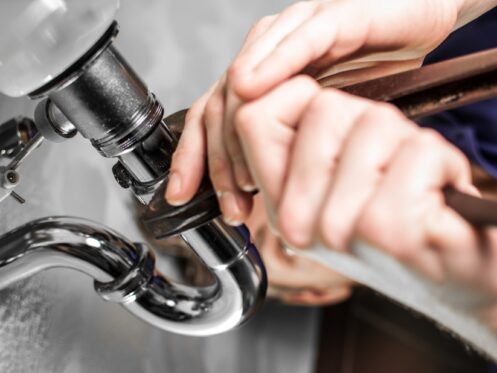If you own an older home, you know all about the character and charm that comes from its unique architectural features, like intricate moldings and beautiful hardwood floors. Older homes were also built to last, crafted with top-notch materials that aren’t used today, thanks to their high costs.
While older homes are distinct and charming, they also have plenty of hidden risks behind the walls. Older plumbing systems come with many challenges and potential safety hazards that can be costly and dangerous.
Here, we’ll uncover the six most common plumbing issues in older homes and how to tackle them to keep your home as charming as when you fell in love with it.
Six Common Plumbing Issues in Older Homes
Aging Pipes
Galvanized steel pipes were used in homes built between the 1920s and the 1950s because they were durable and resistant to rust and corrosion.
Typical lifespan: 20 to 50 years
Copper pipes are known for their longevity and corrosion resistance. They became popular home plumbing materials in the 1950s and are still a preferred choice.
Typical lifespan: 50+ years
Polybutylene pipes gained popularity between the 1970s and 1990s because of their low costs. However, it was quickly realized that they were especially susceptible to breakage and leaks.
Typical lifespan: 10 to 15 years
Aging pipes can cause corrosion, contaminate water, and pose health risks, while frequent leaks may lead to water damage and mold. Issues like reduced water pressure from buildup can make daily activities frustrating.
Pipes Impacting Water Quality
Lead Pipes
Before the 1980s, lead pipes were commonly used in home plumbing systems until it was discovered that lead could leak into drinking water and pose serious risks to water quality and health.
Cast Iron Pipes
Cast iron pipes are more vulnerable to internal corrosion over time, so their interior may become easily blocked, resulting in restricted water flow. This corrosion leads to leaks and bursts and can contaminate your water supply with rust and mineral particles.
Lead Paint and Asbestos
Homes built before 1978 risk releasing hazardous lead dust during plumbing repairs from deteriorating paint. It’s crucial to take precautions or hire professionals for safe lead paint removal.
Additionally, disturbing old asbestos insulation releases tiny fibers into the air, posing serious health risks like lung disease and cancer. Handling asbestos with extreme caution is crucial and typically requires trained professionals for safe removal.
Old Drain Backups
Debris accumulation and tree rot intrusion can lead to old drain backups. Watch for signs like slow drains, frequent backups, and foul odors.
Water Heaters with Sediment Buildup
If you’re experiencing weird noises from your water heater and decreased water quality, it’s likely a sentiment buildup issue. Regular inspections and flushing can extend the life of your water heater.
Old Fixtures Prone to Breaking
If your home has old faucets, showerheads, and toilets, you might be prone to unnecessary and costly problems.
Call the Grand Rapids Plumbing Experts
Residents of Grand Rapids love the prevalence of neighborhoods that boast older homes for their unique charm. They know that with charm comes unique plumbing challenges. The cold winters also greatly impact the performance and longevity of the plumbing systems in Grand Rapids homes.
Whether you’ve got minor or major plumbing issues, call the licensed and certified professionals at Service Professor. We’ve been tackling old plumbing in West Michigan homes since 1978, fixing them in a snap with expertise and efficiency.
Trust us to handle your plumbing needs with the speed and professionalism that only decades of experience can bring.
Contact us online to schedule your free estimate on old plumbing repairs and renovations today.

